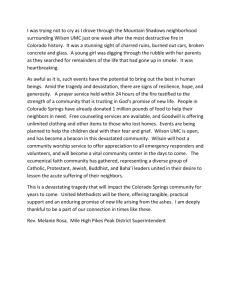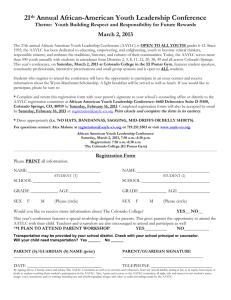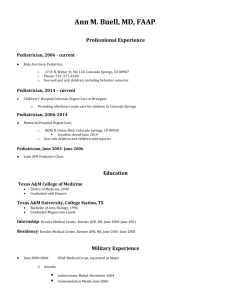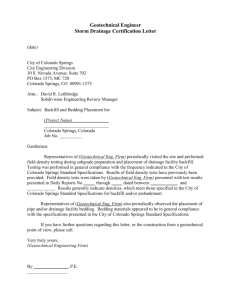Profiling Hazard Events
advertisement
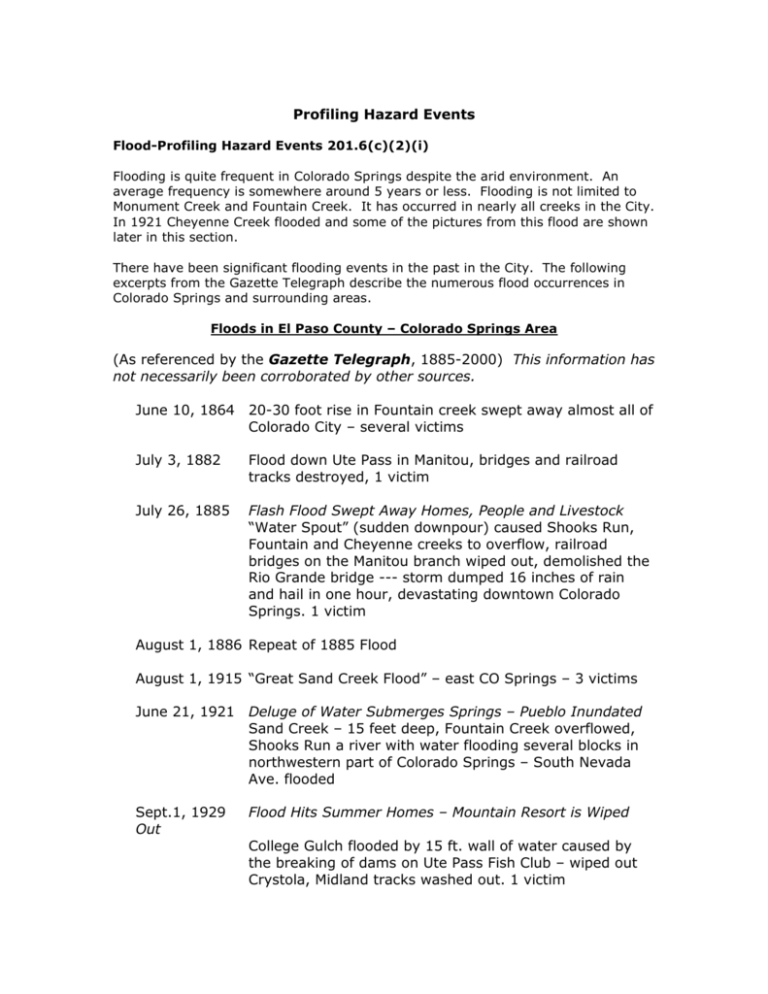
Profiling Hazard Events Flood-Profiling Hazard Events 201.6(c)(2)(i) Flooding is quite frequent in Colorado Springs despite the arid environment. An average frequency is somewhere around 5 years or less. Flooding is not limited to Monument Creek and Fountain Creek. It has occurred in nearly all creeks in the City. In 1921 Cheyenne Creek flooded and some of the pictures from this flood are shown later in this section. There have been significant flooding events in the past in the City. The following excerpts from the Gazette Telegraph describe the numerous flood occurrences in Colorado Springs and surrounding areas. Floods in El Paso County – Colorado Springs Area (As referenced by the Gazette Telegraph, 1885-2000) This information has not necessarily been corroborated by other sources. June 10, 1864 20-30 foot rise in Fountain creek swept away almost all of Colorado City – several victims July 3, 1882 Flood down Ute Pass in Manitou, bridges and railroad tracks destroyed, 1 victim July 26, 1885 Flash Flood Swept Away Homes, People and Livestock “Water Spout” (sudden downpour) caused Shooks Run, Fountain and Cheyenne creeks to overflow, railroad bridges on the Manitou branch wiped out, demolished the Rio Grande bridge --- storm dumped 16 inches of rain and hail in one hour, devastating downtown Colorado Springs. 1 victim August 1, 1886 Repeat of 1885 Flood August 1, 1915 “Great Sand Creek Flood” – east CO Springs – 3 victims June 21, 1921 Deluge of Water Submerges Springs – Pueblo Inundated Sand Creek – 15 feet deep, Fountain Creek overflowed, Shooks Run a river with water flooding several blocks in northwestern part of Colorado Springs – South Nevada Ave. flooded Sept.1, 1929 Out Flood Hits Summer Homes – Mountain Resort is Wiped College Gulch flooded by 15 ft. wall of water caused by the breaking of dams on Ute Pass Fish Club – wiped out Crystola, Midland tracks washed out. 1 victim May 30, 1935 Memorial Day Flood Monument Creek floods 200 square blocks of city, southern end of Co Springs under water, 8 victims – estimated $ 1.769 million in damages. Monument Creek had a peak flow of 50,000 cfs into Fountain Creek June 15-19, 1965 Storm in Region Causes Wide Damage 7” of rain, 2-3” hail in Security and Fountain areas – Sand, Squirrel, and Fountain Creek overflowed, Hancock Expwy. Section washed away, 8-10 bridges swept away Tornados, Floods Continue to Plague Pikes Peak Region Jimmy Camp Creek runs at 124,000 cfs, Fountain Creek rampaging, all out of town public transportation at a standstill, highways closed, , bridges torn out, flash flood down Crews Gulch, Stratmoor Valley evacuated, Fountain Valley School Reservoir dam burst, Janitel Bridge damaged, hundreds seek refuge in Co Springs Auditorium – estimated $ 3.4 million in damages for El Paso County July 24, 1965 Flash floods cause landslide on Cheyenne Mtn. Zoo, damage to ape and hippo houses, Seven Falls area. Boulders dislodged from Cheyenne Mountain crossed Highway 115 onto Fort Carson July 24, 1970 Flash floods cover Constitution Ave. to Fountain Blvd, 1 victim August 20, 1970 9-11” of rain cause flooding, rock slides in Rock Creek Canyon July 21, 1972 Jimmy Camp Creek Washout, $50K damage to roads and bridges July 2, 1980 Heavy rains cause flooding July 21, 1985 I25 closed down, nearly 2-5” of rain, Gold Camp and Old Stage Rd. closed July 14, 1996 El Paso County hardest hit with numerous washed-out roads and bridges – statewide flood damage estimates exceed $38 million July 27, 1996 Springs is Hammered Again Flooding, hail, power outages, 1-3” rain – (1.5” in 45 minutes) Fountain and Monument creeks overflowed, water 3 ft. deep on streets June 11, 1997 Flood Waters Still Raging Through Area 6-10” rain, roads closed, Fountain and Cheyenne creeks washed out bridges, evacuations in Red Rock Canyon and Manitou, Seven Falls closed July 30, 1998 3-4” rain in El Paso County, washes out County Fair, streets flood, bridge collapse May 2, 1999 Waterlogged Four days of rain/snow – 13” in Seven Falls, 12.16” in Manitou Springs, Monument 7.9” - Fountain Creek overflowed The 1935 Flood appears to have been worse than previously documented. This flood was chosen for more analysis because it was an actual historical event. The intent of the Flood Section of the PDM is to emphasize the need to continue to look at the flood risks in all sections of the City that affect public safety, utilities, residential areas, commercial facilities, businesses, non-profit organizations and so forth. The 1935 flood is used as an example because it is beyond the scope of the PDM to address every flood in detail. The 1935 Flood boundaries, high water elevations and other parameters were determined based on the historical evidence. This was then mapped onto a map of the city. In addition, present day photos of the area were taken and overlaid with the boundaries and some high water marks. As the details of the 1935 flood were analyzed a number of facts emerged that are included on the following pages. Like most disasters it would have been more beneficial if there was better documentation of the 1935 Flood but like disasters that occur today – documentation is secondary to people trying to save a persons life, property and animals. The following pictorial or graphical items follow this page and highlight the severity of the flood risk to Colorado Springs. 1. The 1935 Flood in Colorado Springs (1921 Flood and 1935 Flood pictures) 2. The 1935 Flood boundaries overlaid on present day Colorado Springs 3. 1973 Corps of Engineers flood map for southwest Colorado Springs 4. Present day photographs with 1935 Flood boundaries and high water marks 5. Flood CD with present day photos compared to the 1935 Flood (located on the inside of the binder cover) 6. Floodplain Data for Colorado Springs 7. FEMA Flood Maps with data for values, structures and persons 8. Floodplain Regulation Flow Chart Probability of future occurrence Flooding has occurred frequently in Colorado Springs. It is common to have some sort of flood every 5 years or less. The history of the area and of Colorado Springs contains a wealth of information that documents earlier floods. Based on the past 140 years of documented flood history it is safe to estimate that floods will reoccur in the future. Historical data is a good indicator of the future. There have been numerous small or singular drainage basin flooding events to major flooding events that affected the entire region. The magnitude or severity of a future flood is not as easy to predict as the likelihood of a future flooding event. A wise course of action is to assume the worse and establish mitigation plans and other long-term planning based on a worse case scenario (e.g. repeat of the 1935 flood) The geographical extent or areas that may be affected The entire geographical area with locations within 20-30 vertical feet of an existing streambed are at the greatest risk A major dam failure during a flood significantly compounds the problem and disaster. A failure of a major dam was not considered at this time in the PDM Plan. Conditions such as topography, soil characteristics, meteorological conditions, etc. make the area prone to flooding. The saturation level of the soil/ground, drought history, previous near-term precipitation record, vegetation or lack thereof, precipitation rate, slope of the ground, condition of the stream bed, condition and capacity of storm sewers and other factors all have a bearing on the amount of runoff and ability of the existing natural and man-made systems to handle any given storm event. These in turn influence the severity of the flood Wildfire-Profiling Hazard Events 201.6(c)(2)(i) The return frequency of major fires in the Colorado Springs area is 50 years or less. This is not anywhere near the return frequency of a flood in Colorado Springs but it is a major concern because of the large amount of fuels that exist in the Wildland Urban Interface. As future development occurs in the Wildland Urban Interface the likelihood of a fire is further enhanced. Even without further development, as long as fuels are not removed, over time the increase in dead vegetation will continue to cause fuels to accumulate. Suppression of wildfires over the years has also allowed fuels to collect in most forests. In hindsight this human intervention into a normal cycle of fire has allowed fuels to collect so that if there is a fire its effects and damages are far greater than if fire had been allowed to take its natural course during the past. On the following pages are a number of maps that illustrate the wildfire risk in Colorado Springs. These are as follows: The Big Burn of 1854 This map shows a large region in central Colorado that suffered a number of large fires up until the map was printed in 1898. One the fires that contributed to this map is described on the page preceding the map. The Big Burn of 1854 refers to a fire that burned from Cheyenne Mountain (southwest Colorado Springs) approximately 70 miles to Wilkerson Pass, which is west of Colorado Springs Wildland Urban Interface in Colorado Springs There are three map sheets here that show the extent of the Wildland Urban Interface in Colorado Springs. Most parcels within the City limits and within the Interface have been assessed as to the risk they pose with respect to a wildfire. The third map shows an enlarged risk assessment at the neighborhood level for a neighborhood in southwest Colorado Springs. Illustration of the maximum Hayman Fire burn rate if it occurs in Colorado Springs. These two maps show how much of a geographical area will be affected by a fire if it burns at the same peak rate as the Hayman Fire in 2002. One map is a typical topographical map and the second map is orthographic aerial photos with the burn rate annotated on the map. The final enclosure is a poster that illustrates defensive measures for owners that live in the Wildland Urban Interface and the source for this information is the FireWise Program. Description of past occurrences of the hazard The majority of the information in this section came from the 2001 Colorado Springs Fire Department’s Wildfire Mitigation Plan 1850s to the present, very limited data and information is available. Only in the past 10 to 25 years has more data been available that documents the risk and dangers of wildfires. The documented large fires, that occurred in vicinity of Colorado Springs, include the Big Burn of 1854 (see previous map), the Camp Carson/Cheyenne Mountain Fire of 1950 and the Hayman Fire of 2002. Every year wildfire destroy hundreds if not thousands of homes. It appears that the risk and the probability of occurring again continue to get greater. Intensity or severity We would expect the fires to be similar to California. Since there are many variables (and even the variables change with time and environmental conditions) there is no way to precisely know how a fire will spread. Sophisticated models are just models and are helpful but do not provide solid conclusive information. San Diego’s Cedar fire at peak burn rate consumed 8,000 acres in one hour. This was listed on CNN’s internet website. (28 October 2003) The Hayman Fire in 2002, at the peak burn rate, burned 68,000 acres in one day. The Wildland Urban Interface in Colorado Springs is 45 square miles or 28,800 acres. It is recognized that the City’s Wildland Urban Interface is not one big cluster so there is no insinuation that this could all burn in one day but this fact does provide for an interesting comparison. The Hayman Fire also burned at a peak rate of ½ mile in 4 minutes. Most people, unless they are in a vehicle and on a road that is going in a direction away from the fire could not escape a fire that is burning ½ mile in 4 minutes. This rate (7.5 mph) is the equivalent of a fire moving from Highway 115 to Fire Station 16 in 8 minutes. Or the fire could burn from the Cheyenne Mountain Zoo to NORAD in 16 minutes. (See previous maps) Probability of future occurrence Wildfires occur every year in Colorado, only the location varies Severity will depend on preparedness, weather, moisture levels, and type of fuels, current environmental conditions as well as other variables. Currently Colorado is in a very serious drought. Colorado Springs has been under water restrictions for well over a year. The environmental conditions, even in winter months are currently very conducive to a large wildfire starting and spreading quite quickly. Preparedness depends on pre-fire mitigation and other variables that are strongly influenced by a wide variety of property owners and their interpretation of what is acceptable risk and mitigation. The geographical extent or areas that may be affected Has the potential to consume large amounts of acreage as was the case with the Hayman Fire If we have a repeat of historical fires, the Hayman fire or a fire similar to the October 2003 California fires the entire eastern slope of the Pikes Peak region and Black Forest could be affected. Historical fires have also started on the eastern face of Cheyenne Mountain and burned to Wilkerson Pass (The Big Burn of 1854) or further. Conditions such as topography, soil characteristics, meteorological conditions, etc. that make the area prone to hazards. Contributing factors include: a. Lack of moisture in the vegetation b. Diseased trees c. Overgrowth d. Failure to clear down and dead or deadfall On the periphery of Colorado Springs, in El Paso County, are several areas of concern for the County. These include the Black Forest (north of the City), southwest part of the County (southwest of the City) and Ute Pass (west of the City). These are also great concerns for the City. Landslides-Profiling Hazard Events 201.6(c)(2)(i) In the case of landslides the historical documentation of landslides is very incomplete and in many cases would never be noticed unless someone was living in vicinity of the landslide and happened to notice subtle changes in a hillside. In Colorado Springs, along the Front Range, and in the mid west landslides are part of the geography and natural events that occur on a periodic basis at unpredictable locations. In a number of areas in Colorado Springs you can observe the terrain and by its hummocky appearance know that at some point in the past the hillside failed. In other areas it is not so obvious, even if you have conducted a formal geotechnical subsurface investigation. This problem has occurred for hundreds and thousands if not millions of years at some locations. The dilemma is essentially that some open space hillsides are stable but they are much steeper than others that have failed. In other cases a hillside that is not steep but has a house on top has failed whereas a house on top of another slope (that is steep) appears to be in perfect condition. Development is frequently cited as a condition that precipitates failure but this is not a universal contributing factor. In terms of recent history there are several notable events: 1995 There was more precipitation in the spring time than normal and this appears to be the reason that two slopes failed in the southwest part of town. 2 owners had structures that were destroyed and 2 owners had homes that were badly damaged. One of the two destroyed homes was taken down in 1998. 1999 The rain in April/May 1999 that precipitated a local Presidential Disaster Declaration for flooding was an apparent factor in causing additional slopes to fail in residential neighborhoods. The slopes that failed in 1995 were further destabilized by the rains in 1999. There were at least 10 additional slopes or hillsides that had movement as a result of the rains in 1999. In late 1999 FEMA received several hundred million dollars from Congress to help with some of the nation’s disasters in states that still had “Unmet Needs’. FEMA set aside over $4 million for landslides in Colorado Springs. Hence, the name of the program became the “Unmet Needs Program”. This relief was an acquisition of landslide properties “Unmet Needs Program” that began in February 2000. After the program began some of the owners, at several of the sites, declined further participation in the FEMA “Unmet Needs Program” (Colorado Springs Office of Emergency Management Project 2000-1) out of concern that the various inspections performed as part of the validation of the landslide damage would jeopardize their real estate values so they withdrew. The Colorado Geological Survey was asked to assist in mapping the landslides and 8 sites (including the two from 1995) were mapped. This part of the Program was for owners that wanted to be considered for acquisition. The prioritized list for acquisition was finalized in early April 2000. In May 2000 the Small Business Administration offered to provide low interest disaster loans to owners affected by the landslides. At about this time other owners who did not come forward for the acquisition program indicated that they too had landslide damages. As a result of this there was a second phase to the validation of the landslide damages. The second phase was for owners that missed the opportunity to be considered for acquisition but wanted to go on record as having damages and or be considered by the SBA for a low-interest loans. As a result of this second phase Colorado Springs asked the Colorado Geological Survey to inspect several more homes in July 2000. These inspections resulted in documenting 4 more sites bringing the total officially documented landslide sites to 12 (including the 2 from 1995). Since the year 2000 other owners have come forward to identify homes that are on slopes that have failed. Unfortunately, there is nothing that could be done because the window of opportunity for applying for the FEMA/City acquisition program was only open for February 2000. Some of these later problems materialized in 2002 and 2003. This delayed reaction by the ground is not unusual. It takes years for water to work itself through some types of clay. Typically when the shale that is near the ground surface weathers due to ground water or chemicals in the ground water or from other causes it will turn into clay. As a result water that saturated the ground several years ago may still be continuing to affect the stability of slopes. The landslide problem will probably be a problem for many years to come. Once a slope has failed the strength of the underlying shale or clay that is in the failure zone will never go back to its original strength and even in dry years these slopes can continue to show movement (it may slow down to almost zero but it does not take the same force to sustain movement after failure). An unreported landslide exists on the west side of town where a hill is failing above about 12-15 residential structures. The owners below this hill probably have no idea that the slope is failing. None of the owners have come forward in the past 4 years to identify this problem. Perhaps it will reach equilibrium and completely stop but this is not the likely outcome. This slope has been in this condition for over 4 years and may have been precipitated by the spring 1999 rains. At the present time it does not appear to be affecting any homes at its toe. In summary, the landslide problem in Colorado Springs is not a natural disaster where you can accurately predict what slopes are going to fail or predict what slopes will remain stable. This unpredictability places a large fuzzy cloud over any attempt to quantify future losses. The following photographs, documents and maps follow this section. 1. Landslide Aerial and Ground Photographs: These are samples of areas in Colorado Springs that have active landslides and some of the buildings that had damage or were completely destroyed. These photographs are representative of the situation and do not show all areas or all buildings that were destroyed, damaged or threatened and they do not show all areas of town. 2. Regency Drive Landslide Map (with the Colorado Springs Utilities Facilities Information Management System (FIMS) Base Map): This is a typical map that was done for each landslide site that was in the acquisition program and was the result of the FEMA “Unmet Needs Program” where homes were prioritized for acquisition if the owner wanted to participate and the home was destroyed, damaged or threatened by active landslides. The maps were produced in March 2000 by the Colorado Geological Survey in coordination with the Colorado Springs Office of Emergency Management (one of these maps – Regency Drive Landslide is included in this section to provide an example of the mapping that was done to support this FEMA grant). 3. Before and After Photographs of several homes that were acquired as part of the FEMA “Unmet Needs Program” or OEM Project 2000-1. These photographs were taken before homes were removed and then taken again in January 2004. The final closeout of the FEMA “Unmet Needs Program” will occur by 31 March 2004. 4. Map Series 42 by the Colorado Geological Survey (CGS). This is the latest of a number of geologic hazard maps produced by the CGS and others. Its title is “Map of Potential Areas of Landslide Susceptibility in Colorado Springs, El Paso County, Colorado” Only a small portion of one of 3 map sheets that is included in the report is included in this Plan. It is a collection of various studies and other reports and attempts to highlight areas in Colorado Springs that may be susceptible to landslides but it is by no means definitive in nature. Probability of future occurrence Historical data is generally a good indicator of the future but in the case of landslides it is only a general statement and specific locations cannot be identified (unlike floods where the potential problems can be readily identified). Other slopes have failed besides those included in FEMA “Unmet Needs Program” project that was in response to the 1999 Disaster. There is no precise or accurate way to predict what other slopes may fail in the future or to what extent slope failures may continue to be a problem. A worse case scenario could develop for subsequent landslides in the future if several prolonged low intensity saturating rainstorms (e.g. where it drizzles for 4 or more days continuously per storm) occur over a few months. Under these conditions slope failures may begin to develop. Depending on the condition of the underlying material some of this moisture may be able to penetrate quickly to reach material that is susceptible to failure. At other locations it may take quite a bit of time for the moisture to reach a potential weak layer or zone. Landslides that have already occurred could be reactivated by excess moisture conditions. Eventually the drought that is currently in the mid-west will be over and moisture content and precipitation levels will increase. Additional slope failures will occur – it is just a question of time and how wide spread the destruction and damage will be. The probability of occurrence is higher in areas that have weak underlying rock. Once a slope has failed in the weak bedrock the strength of the failed material is permanently decreased so that it does not take a lot of moisture or maybe none at all to allow continued movement. The magnitude or severity of the future event The extent of future damage can be from light or minimal damage to total destruction of structures. The geographical extent or areas that may be affected Primarily the west side of Colorado Springs with isolated areas in the rest of the City. Conditions such as topography, aspect, moisture content, previous failure history at the specific site, soil properties or characteristics, slope, angle of bedrock bedding planes/joints, presence of human activity and other variables, etc. influence the probability of occurrence. Severe Weather-Profiling Hazard Events 201.6(c)(2)(i) Historical frequency is not a valid parameter for assessing severe weather effects. The unpredictability of weather is a reason insurance for automobiles and homes is so high in Colorado. If major hail storms concentrated in one area under certain conditions at specific timeframes during the year then the solution would be simply to make building codes more stringent and take measures to avoid damage to automobiles. Of all the types of severe weather lightning is probably the most predictable, not in the location it will strike but in the fact that El Paso County and the Colorado Springs area receive the second most number of lightning strikes in Colorado. In Colorado Springs the average number of strikes is 15-20 cloud to ground flashes per square mile per year and for El Paso County 13 cloud to ground flashes per square mile per year (Source: Tom Magnuson, National Weather Service, Pueblo). Hail generally occurs most severely in the foothills of the Rocky Mountains and continuing to the east. Tornadoes have occurred in the foothills and to the east but they are about 2% of the severe weather events from 1995 to 2000. With respect to tornadoes the question becomes - Do you invest precious mitigation resources to address a tornado when the probability is very low? Typically tornadoes are F3 or weaker. Winter storms have affected different areas at different times. In 2003 northern Colorado, including the Denver area was hit hard. Denver received close to 30 inches of snow during the March 17-20 blizzard (Colorado Office of Emergency Management Website “2003 in Review”). In 1997 Colorado Springs endured a blizzard. Number of Severe Weather Events per Colorado County 1995 – 2000* County # of Severe Weather Events Hail El Paso 235 203 Fremon t 13 9 Pueblo 79 62 Teller 14 12 Size of Hailstones 113 82 8 0 7 1 0 1 0 42 18 2 0 8 4 0 .75 to< 1” 1 to< 2” 2 to< 3” >3 “ .75 to< 1” 1 to< 2” 2 to<3” 3 to 4” >4 “ .75 to< 1” 1 to < 2” 2 to< 3” >3 “ .75 to< 1” 1 to 2” > 2” Torn ado Wind > 58 mph Annual Lightning Strikes** 5 27 27,500 1 3 10,700 3 14 15,500 1 1 5,700 (*Source: National Weather Service, Warning Coordination Meteorologist Tom Magnuson, 2003) [**Cloud to Ground Lightning Strikes] Lightning in Colorado’s High Country Assessing Vulnerability- Description of the jurisdiction’s vulnerability. Summary of the jurisdictions vulnerability to this hazard and its impact on the community Severe Weather- Assessing Vulnerability: Overview 201.6(c)(2)(ii) (Please see background for Severe Weather above) Severe Weather-Assessing Vulnerability: Identifying Assets 201.6(c)(2) (ii) (A) This is a large open ended question because in theory every person, structure, facility, building, truck, car, etc. can be affected by lightning, hail, tornadoes and winter storms. Proper precautions will limit the damage of some forms of severe weather as follows: Lightning Personnel should remain indoors and away from any material or device that can act as a lightning rod. Lightning rod/grounding systems can improve a building’s performance in the event it takes a hit. Staying off of high ridges, away from large elevated open spaces will reduce the chances of the person or facility taking a hit. Every location in Colorado Springs is susceptible to lightning with ridge lines, elevated locations and open areas being more susceptible Hail Hail is very unpredictable. Commercial construction that is made of brick, stone or other durable material tends to handle a hail storm better than typical residential or a wood frame constructed building. Automobiles and light trucks are very susceptible to hail damage if they are not under protective cover. All structures in Colorado Springs are vulnerable to being struck by hail and the damage is related to the type of materials used in construction. Tornadoes An F3 hit Manitou Springs in June 1979. An F2 hit Ellicott on 28 May 2001. Normal tornadoes in Colorado are F0 to F1. F2 and F3 tornadoes are not very common. The only F4 on record in Colorado was in Baca County in 1977 (Tornado Project website). The stronger tornadoes occur more often on the plains further east of Colorado Springs. On 1 January 2004 high winds in excess of 100 mph hit southwest Colorado Springs and while not a tornado tore off concrete tile roofs from residential structures. Some of the broken tiles became projectiles and penetrated part way into nearby wood decks. An F0 tornado can do damage to buildings that are under construction and loose material that may be at construction sites, in yards and things like outdoor furniture. An F1 can turn loose items into missiles. F2s and above can destroy mobile homes, wood frame homes and just about any building that man can make. It is very uncommon for a tornado to be within the city limits. This fact may change as Colorado Springs continues to expand eastward onto the plains. In summary, the assets that will probably be most vulnerable to tornadoes in Colorado Springs have minimal risk and are located east of I-25 where the plains start and continue to the Kansas border. Fujita Tornado Scale* F0 F1 F2 F3 F4 F5 40-72 mph 73-112 mph 113-157 mph 158-206 mph 207-260 mph 261-318 mph [*Source: National Climate Data Center, NOAA website] Winter Storms Colorado Springs has dealt with large snowstorms/blizzards in the past. The impact is usually only temporary. In Colorado Springs most of the year consists of sunny days and this helps melt snow and clear roads and sidewalks. This fact is taken in to consideration by the city in reducing the amount of snow clearing equipment that is needed to recover from a storm. Most snowfalls are less than a foot and this does not pose a significant problem for the city – usually in less than several hours, when the sun is shining, the main roads are in good condition. When the city receives any accumulation of snow the school districts typically delay the start of school by 2 hours. This is sufficient time for the sun to melt snow and the priority roads to be cleared. Larger amounts of snow falls take a little longer to clear but the impact is usually no more than one or two days. All areas in Colorado Springs are subject to large amounts of snowfall. Sometimes it will only occur in certain parts of town while during other storms it will hit the entire City. No one section of town and no one type of population is more at risk because of their location because for the most part severe weather can occur anywhere. The highly variable nature of severe weather could affect small or large geographical areas. Severe Weather-Assessing Vulnerability: Estimating Potential Losses -Estimate of potential dollar losses to vulnerable structures and description of the methodology used to prepare the estimate 201.6(c)(2) (ii) (B) Damages due to severe weather are greater than $3 billion in the US annually (1997 – 2002) (NOAA Severe Weather Statistics @ NWS Website) for Lightning, Hail, Tornadoes and Winter Storms (This does not include tropical storms, hurricanes, high wind and other forms of weather that are considered Severe Weather) The table below gives a summary of the damages annually in the United States due to Lightning, Hail, Tornadoes and Winter Storms. United States Severe Weather Statistics (Property and Crop Damages in billions of dollars) (Source: NOAA Severe Weather Statistics @ NWS website) Lightning Hail Tornadoes Winter Storms 1997 0.041 0.401 0.737 0.774 1998 0.041 1.5 1.74 .528 1999 0.032 0.600 1.998 0.062 2000 0.039 .571 0.430 1.035 2001 0.046 2.64 0.638 .104 2002 0.044 .479 .802 .752 Total 0.243 6.19 6.345 3.26 In June 2002 Colorado Springs was hit by a significant hail storm that caused an estimated $24.1 million dollars in damages. 5,500 auto claims and 2,500 homeowner claims were filed by 19 June 2002. Hail was up to 2 inches in diameter. (Rocky Mountain Insurance Information Association website) Other costly hail storms were in the Denver-metro area. On July 11, 1990 there was $625 million in insured damages in the Denver-metro area. (Rocky Mountain Insurance Information Association website) The F2 Tornado that struck Ellicott on May 28, 2001 caused several million dollars in damage by destroying several mobile homes and causing severe damage to the Ellicott Junior-Senior High School. (2002 Instructional Services, Jefferson County Public Schools, CO website for the Ellicott Tornado) In summary, severe weather can cause millions of dollars in damage if it affects large areas within the city or it can affect small geographical areas. Assessing Vulnerability: Analyzing Development Trends -Description of land use and development trends that affect mitigation options 201.6(c)(2) (ii) (C) Future development for the most part is not any more vulnerable to severe weather than those parts of Colorado Springs that are already developed. Development east of Colorado Springs will be in areas where tornadoes are more likely than along the foothills. These areas are still relatively close to the foothills so there may not be any additional risk from tornadoes. Colorado Springs requires a Class A roof (non-combustible material) on all new residential structures so this will reduce future hail damage to homes. Most businesses, government office buildings, commercial structures, etc. are largely protected from hail damage because they typically use more durable building materials than residential structures. Lightning protection systems enhance protection from lightning strikes. Outdoor structures such as high voltage transmission towers, electrical primary lines, residential electrical service panels, etc. are typically grounded. Many residential areas in Colorado Springs are fed electrical power by underground distribution systems which helps minimize the effect of lightning, if it occurs in those areas. Masonry or concrete structures are typically able to withstand higher winds and therefore offer the best protection for a lower rated tornado. At the higher F ratings all buildings should be evacuated or the personnel move into basement areas that are capable of supporting the building should it collapse. It is not normal in Colorado Springs to design and construct a building that can withstand a tornado. Future growth in Colorado Springs will primarily be to the east and the northeast and will not increase or decrease the risk of damage from severe weather because it can happen virtually anywhere in town. Severe weather (lightning, hail, tornadoes and winter storms) is a fact of life and owners typically must take it upon themselves to be prepared. The western side of Colorado Springs is bordered by National Forests, steep terrain and Manitou Springs. The Northwest part of town borders the United States Air Force Academy. The southern part of town is bordered by Fort Carson. The Southeast part of town is bordered by the airport, Security, Widefield and Fountain. This is the primary reason major growth occurs to the east and northeast. Office of Emergency Management For Public Comment: mailto:SDubay@springsgov.com 719-385-7229

